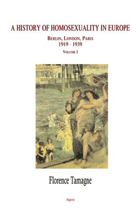 Reviewer
Gene Hayworth brings us another review of homosexuality in history.
This time we read about Europe, specifically Berlin, London, and Paris. Reviewer
Gene Hayworth brings us another review of homosexuality in history.
This time we read about Europe, specifically Berlin, London, and Paris.A History of Homosexuality in Europe : Berlin, London, Paris 1919-1939 Volumes I and II |
| Gene
Hayworth grew up in North Carolina and attended undergraduate school at
UNC - Greensboro. He worked for 10 years as a layout artist, technical
writer, computer specialist and training instructor before returning to
school at the University of Rochester, where he received a Masters
degree in English with a concentration in creative writing, and an MLS
from Syracuse University. He moved to Colorado in 1995 and worked at
CARL Corporation for several years, and in the summer of 1999 he worked
for CARL in Singapore, which resulted in the publication of an article
about his experiences titled "Singapore Libraries Usher in a New Era,"
in Computers in Libraries, 20:6 (Nov./Dec. 2000). He is an avid reader
and has written several book reviews for Colorado Libraries. In
February 2003 he prepared an exhibit at the Fales Library, NYU, on the
Gay American novelist and playwright Coleman Dowell. His critical study
of Dowell appeared in The Review of Contemporary Fiction, Fall, 2002.
Currently he works as a reference librarian for the University of
Colorado at Boulder Libraries. Gene Hayworth would like to hear from you about this review. If you are a writer or publisher with a literary offering or work of non-fiction, please contact Gene directly with your request for a review. |
 A History of Homosexuality in Europe : Berlin, London, Paris 1919-1939 (Two volumes). by Florence Tamagne Algora Publishing, New York. 2004 ISBN 0-87586-252-7, 292 p. (Volume I ) ISBN0-87586-278-0, 343 p. (Volume II) A History of Homosexuality in Europe : Berlin, London, Paris 1919-1939 is a new translation of Florence Tamagne’s doctoral thesis, originally published as Histoire de l'homosexualité en Europe: Berlin, Londres, Paris, 1919-1939 (Editions du Seuil, Paris, 2000). In 1998 Tamagne received her PhD from the Institute of Political Studies in Paris, France, where she studied with the renowned French historian Jean Pierre Azéma. Her new two-volume work, published by Algora, focuses on the three most influential European capitals of the period between the two world wars, 1919-1939. The book provides a thorough, balanced account of the homosexual and lesbian communities in Berlin, London, and Paris, emphasizing the resistance homosexuals faced to find a legitimate place in society in these large metropolitan cities. While conducting her research Tamagne examined a broad and impressive array of documents including literature, police reports, news stories and private correspondence, and she has deftly collated this material into a fascinating historical study. Topics range from the German novel and the construction of lesbian identity to the comparison of National Socialist Germany with the democracies in England and France. A History of Homosexuality in Europe consists of three parts. “Part One: A Brief Apogee: the 1920s, A First Homosexual Liberation,” provides a brief history of homosexuality, and then examines homosexual life during the 1920's, in the aftermath of World War I. The book explores this “golden era” in terms of social movements, clubs, homosexual publications, nightlife and slang, and provides a comparison of the male and female scenes in the three capital cities: Berlin, London, and Paris. “Part Two Unacknowledged Fears And Desires: Ambiguous Speech and Stereotyped Images” suggests that homosexuality became commonplace during the inter-war period. Tamagne examines the medical model imposed on homosexuals and compares such views to self-imposed concepts of identity. “Part Three: A Facetious Tolerance: Losing Ground Under the Repression” analyzes the years leading up to World War II. The introduction of numerous methods introduced to repress homosexuals in 1933, especially with the rise of fascism in Germany, led to anti-homosexual legislation and a backlash against the permissiveness of the twenties. Throughout the work Tamagne discusses relevant literature of the period. The wide range of authors represented in the study include Gide, Proust, Radclyffe, Nathalie Barney, Colette, Vita Sackville West, and Virginia Woolf. One of the most significant aspects of the book is Tamagne’s deft examination of the impact these individuals made on their respective cultures and their seminal role in the development of attitudes toward homosexuals. The book will appeal to scholars of history, GLBT studies, and European literature of the period. Several appendices provide additional valuable material, including German legislation on homosexuality and information regarding the experiments conducted by Dr. Carl Vaernet’s in 1944 at Buchenwald. There is a detailed bibliography that will be useful to any scholar interested in research of the period. |